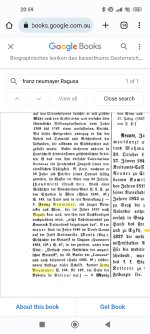Taphrospilus
Well-known member
Sitta neumayer Michahelles, 1830 OD Bd.23 (1830) - Isis von Oken - Biodiversity Heritage Library

 birdsoftheworld.org
birdsoftheworld.org
 de.wikisource.org
de.wikisource.org
So when did he die? 1840 or 1842? According v.26 (1843) - Flora, oder, Botanische Zeitung - Biodiversity Heritage Library he died 18. September 1840.
No idea if the birth year is correct? According Bd.19=Bd.3 (1847) - Linnaea - Biodiversity Heritage Library death 20. September 1840 might be possible. An addtional name may Franz Josef Neumayer according Die Vegetationsverhältnisse der illyrischen Länder, begreifend Südkroatien, die Quarnero-Inseln, Dalmation, Bosnien und die Hercegovina, Montenegro, Nordalbanien, den Sandzak Novipazar und Serbien - Biodiversity Heritage Library
Additional question neumayer grammatically correct or allowed according the code? Not neumayeri(i)?
Not that surprising may that a plant Peucedanum neumayeri Rchb. 21 - Icones florae Germanicae et Helveticae, simul Pedemontanae, Tirolensis, Istriacae, Dalmaticae, Austriacae, Hungaricae, Transylvanicae, Moravicae, Borussicae, Holsaticae, Belgicae, Hollandicae, ergo Mediae Europae - Biodiversity Heritage Library was named for him. Probably as well Neumayera Rchb. 5 - Icones florae Germanicae et Helveticae, simul Pedemontanae, Tirolensis, Istriacae, Dalmaticae, Austriacae, Hungaricae, Transylvanicae, Moravicae, Borussicae, Holsaticae, Belgicae, Hollandicae, ergo Mediae Europae - Biodiversity Heritage Library . IPNI has him as Neumayer, Josef (1791-1840) Neumayer, Josef | International Plant Names Index
Ich erhielt mehrere Exemplare durch H. Neumayer einen thätigen Naturforscher in Ragus, wo sie den auf den Zypressen, die steilsten Kalkfelsen einzeln bekleiden, als Standvogel nicht selten seyn soll.
The Eponym Dictionary of Birds
Birdwatchers often come across bird names that include a person's name, either in the vernacular (English) name or latinised in the scientific nomenclature. Such names are properly called eponyms, and few people will not have been curious as to who some of these people were (or are).Names such...
books.google.de
Neumayer's Rock Nuthatch Sitta neumayer Michahelles, 1830 [Alt. Western Rock Nuthatch]
Franz Neumayer (1791–1842) was an Austrian botanist, entomologist, ornithologist and natural history dealer who lived in Ragusa (Dubrovnik) and collected in Dalmatia (Croatia).
The Key to Scientific Names - Birds of the World
Species accounts for all the birds of the world.
Franz Neumayer (1791-1842) Austrian botanist, bird dealer, collector in Dalmatia, Croatia (Sitta).
BLKÖ:Neumayer, Franz – Wikisource
Neumayer starb im Jahre 1840 im Dorfe Canna auf der Insel Sabioncello.
So when did he die? 1840 or 1842? According v.26 (1843) - Flora, oder, Botanische Zeitung - Biodiversity Heritage Library he died 18. September 1840.
No idea if the birth year is correct? According Bd.19=Bd.3 (1847) - Linnaea - Biodiversity Heritage Library death 20. September 1840 might be possible. An addtional name may Franz Josef Neumayer according Die Vegetationsverhältnisse der illyrischen Länder, begreifend Südkroatien, die Quarnero-Inseln, Dalmation, Bosnien und die Hercegovina, Montenegro, Nordalbanien, den Sandzak Novipazar und Serbien - Biodiversity Heritage Library
Additional question neumayer grammatically correct or allowed according the code? Not neumayeri(i)?
Not that surprising may that a plant Peucedanum neumayeri Rchb. 21 - Icones florae Germanicae et Helveticae, simul Pedemontanae, Tirolensis, Istriacae, Dalmaticae, Austriacae, Hungaricae, Transylvanicae, Moravicae, Borussicae, Holsaticae, Belgicae, Hollandicae, ergo Mediae Europae - Biodiversity Heritage Library was named for him. Probably as well Neumayera Rchb. 5 - Icones florae Germanicae et Helveticae, simul Pedemontanae, Tirolensis, Istriacae, Dalmaticae, Austriacae, Hungaricae, Transylvanicae, Moravicae, Borussicae, Holsaticae, Belgicae, Hollandicae, ergo Mediae Europae - Biodiversity Heritage Library . IPNI has him as Neumayer, Josef (1791-1840) Neumayer, Josef | International Plant Names Index







